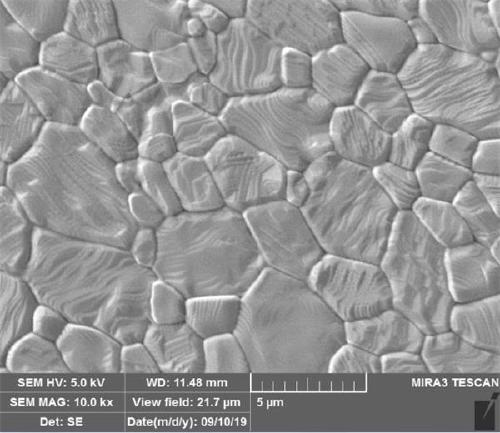Transparent ceramic orthodontic bracket and preparation method thereof
An orthodontic bracket and transparent ceramic technology, applied in the field of ceramics, can solve the problems of difficult thermal decomposition, shrinkage, rearrangement of powder particles, etc., and achieve high three-point bending strength, improved fluidity, and good compatibility. Effect
- Summary
- Abstract
- Description
- Claims
- Application Information
AI Technical Summary
Problems solved by technology
Method used
Image
Examples
Embodiment 1
[0064] a. The specific surface area of alumina powder is 20g / m 2 , particle size 1μm, high-purity alumina.
[0065] b. The binder ratio is: 73 parts of polyoxymethylene, 5 parts of paraffin wax, 5 parts of EBS wax, 7 parts of EVA, 7 parts of PP, 1.5 parts of DOP, 1.5 parts of dispersant-polyether modified heptamethyltrisiloxane .
[0066] 1. Mix the injection molding feed for 2 hours at a temperature of 190 degrees on the internal mixer, then lower the temperature by 50 degrees, and knead for 0.5 hours. The content of high-purity nano-alumina powder in the feed is: 80.5 parts, binder The content is 19.5 parts.
[0067] 2. Put the mixture in step 1 into a screw extruder granulator at a temperature of 180°C and a screw speed of 400 rpm, and cut into pellets to prepare transparent alumina feed granules.
[0068] 3. The feed particles in step 2 are injection-molded on a ceramic injection molding machine to prepare a ceramic bracket.
[0069] 4. Put the ceramic bracket in ste...
Embodiment 2
[0074] a. The specific surface area of alumina powder is 10g / m 2 , particle size of 0.5μm, high-purity alumina.
[0075] b. The binder ratio is: 65 parts of polyoxymethylene, 5 parts of paraffin wax, 7 parts of EBS wax, 10 parts of EVA, 10 parts of PP, 1.5 parts of DOP, 1.5 parts of dispersant-polyether modified heptamethyltrisiloxane .
[0076] 1. Mix the injection molding feed for 2 hours at a temperature of 190 degrees on the internal mixer, then lower the temperature by 50 degrees, and knead for 0.5 hours. The content of high-purity nano-alumina powder in the feed is 81.5 parts, and the content of the binder The content is 18.5 parts.
[0077] 2. Put the mixture in step 1 into a screw extruder granulator at a temperature of 180°C and a screw speed of 400 rpm, and cut into pellets to prepare transparent alumina feed granules.
[0078] 3. The feed particles in step 2 are injection-molded on a ceramic injection molding machine to prepare a ceramic bracket.
[0079] 4. P...
Embodiment 3
[0083] a. The specific surface area of alumina powder is 7g / m2 , particle size of 0.5μm, high-purity alumina.
[0084] b. The binder ratio is: 60 parts of polyoxymethylene, 5 parts of paraffin wax, 10 parts of EBS wax, 10 parts of EVA, 10 parts of PS, 2 parts of DOP, 3 parts of dispersant-polyether modified heptamethyltrisiloxane.
[0085] 1. Mix the injection molding feed for 2 hours at a temperature of 190 degrees on the internal mixer, then lower the temperature by 50 degrees, and knead for 0.5 hours. The content of high-purity nano-alumina powder in the feed is 83 parts, and the amount of binder Contains 18 servings.
[0086] 2. Put the mixture in step 1 into a screw extruder granulator at a temperature of 190°C and a screw speed of 400 rpm, and cut into pellets to prepare transparent alumina feed granules.
[0087] 3. The feed particles in step 2 are injection-molded on a ceramic injection molding machine to prepare a ceramic bracket.
[0088] 4. Put the ceramic brack...
PUM
| Property | Measurement | Unit |
|---|---|---|
| Granularity | aaaaa | aaaaa |
| Density | aaaaa | aaaaa |
| Three point flexural strength | aaaaa | aaaaa |
Abstract
Description
Claims
Application Information
 Login to View More
Login to View More - R&D
- Intellectual Property
- Life Sciences
- Materials
- Tech Scout
- Unparalleled Data Quality
- Higher Quality Content
- 60% Fewer Hallucinations
Browse by: Latest US Patents, China's latest patents, Technical Efficacy Thesaurus, Application Domain, Technology Topic, Popular Technical Reports.
© 2025 PatSnap. All rights reserved.Legal|Privacy policy|Modern Slavery Act Transparency Statement|Sitemap|About US| Contact US: help@patsnap.com

